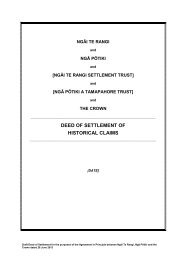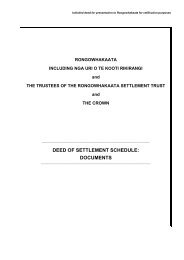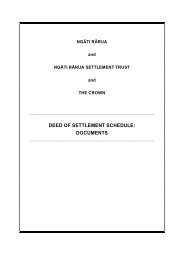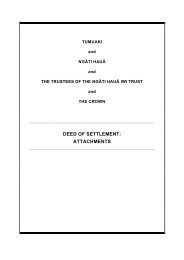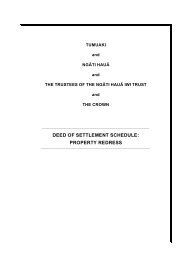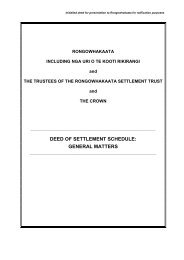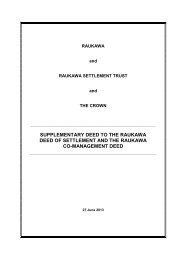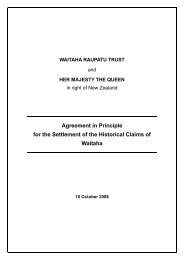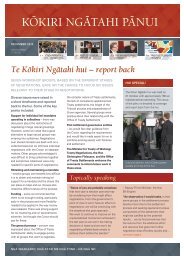Ngati Haua Deed of Settlement - Terabyte Interactive
Ngati Haua Deed of Settlement - Terabyte Interactive
Ngati Haua Deed of Settlement - Terabyte Interactive
Create successful ePaper yourself
Turn your PDF publications into a flip-book with our unique Google optimized e-Paper software.
NGĀTI HAUĀ DEED OF SETTLEMENT2: HISTORICAL ACCOUNTthe peace made with Tamehana, describing it as “a declaration <strong>of</strong> allegiance to theQueen”.JULY 1865 PETITION2.76 On 18 July 1865 Tamehana wrote a further petition to Parliament, more directlyconcerned with rebutting the many accusations levelled against him. He observed thathe had been called “an evil man, a rebel, a murderer”, and many damaging words hadbeen written to Queen Victoria concerning him. Tamehana stated he had only taken uparms in self-defence after Māori living in South Auckland had been forcibly expelledfrom their homes and the Mangatāwhiri River was crossed by British troops.Tamehana added: “Am I a man <strong>of</strong> murder? I only fought for my body and my land; I hadnot any wish to fight”. He again requested that someone be appointed to inquire intothe allegations that had been made against him. He maintained that his letter <strong>of</strong>warning to a Tauranga missionary in 1863, which warned <strong>of</strong> the possibility <strong>of</strong> an attackby Māori on that settlement, had been misinterpreted as evidence <strong>of</strong> his own hostileintent, but that an independent arbitrator would disprove this allegation.2.77 The Crown did not establish an independent inquiry into who had been responsible forthe war, arguing that the actions taken had been “absolutely necessary for the safety <strong>of</strong>the Colony”. Tamehana repeated his plea when the Auckland Civil Commissionervisited Matamata in December 1865.WIREMU TAMEHANA IN WELLINGTON2.78 In May 1866 Governor Grey met with Wiremu Tamehana during a visit to Waikato. Hepersuaded Tamehana, who was by this time in very poor health, to travel to Wellingtonand present his grievances directly to Parliament.2.79 On 24 July 1866 Wiremu Tamehana presented his third and final petition to Parliament.This petition again reviewed events leading up to and during the Waikato War.Tamehana referred to his ‘Great Darkness’ and ‘Sorrow-<strong>of</strong>-heart’ (‘i Pourinui, iNgakaumamae’) and stated that he had travelled to Wellington in the hope that thegreat weight upon him might be lifted. He asked that the confiscated Waikato lands bereturned and criticized the conduct <strong>of</strong> the Crown forces during the war.2.80 On 11 August 1866 Wiremu Tamehana gave evidence before a Parliamentarycommittee specially appointed to consider his petition. The committee chairmandeclined to set up a full inquiry into Tamehana’s conduct and advised that the return <strong>of</strong>the confiscated Waikato lands in full was not possible.2.81 Wiremu Tamehana was asked to select a small piece <strong>of</strong> land for himself and his tribe.He declined to do so, insisting that he had travelled to Wellington to seek the return <strong>of</strong>all <strong>of</strong> Waikato to its rightful owners. On 4 September the committee issued its report,recommending that the petition be referred to the Superintendent <strong>of</strong> Auckland Province.No further action appears to have been taken regarding the petition.2.82 Wiremu Tamehana’s health continued to deteriorate after his return from Wellington.Worn out and depressed at his failure to obtain the return <strong>of</strong> Kīngitanga lands and thepublic restoration <strong>of</strong> his name, the rangatira died at Peria on 27 December 1866.2.83 Ngāti Hauā today remembers Wiremu Tamehana as a man <strong>of</strong> peace, and a deeplyprincipled person, who was wrongly branded a war maker by some <strong>of</strong> hiscontemporaries.20



